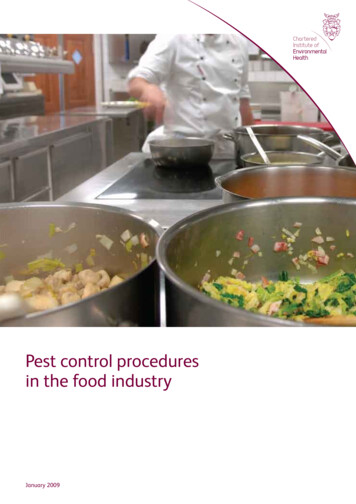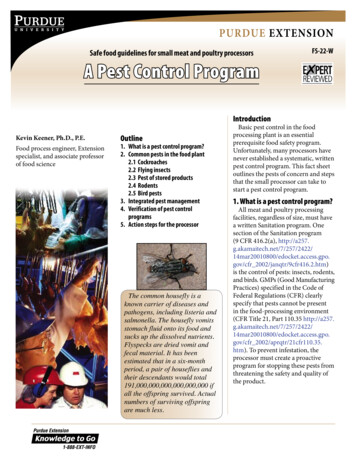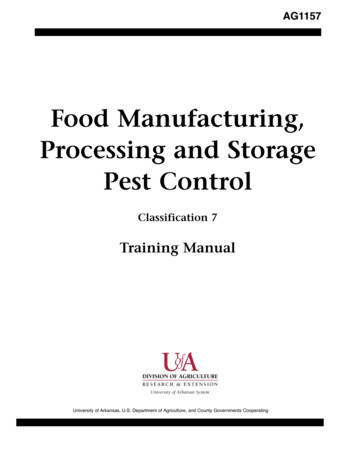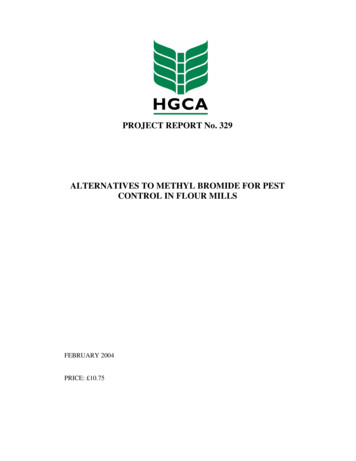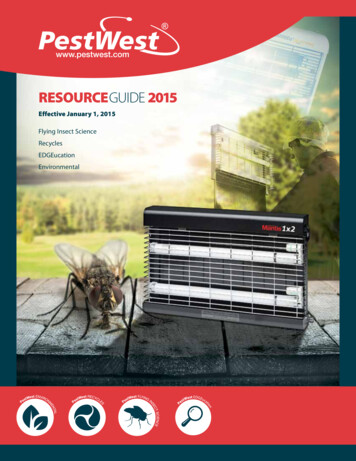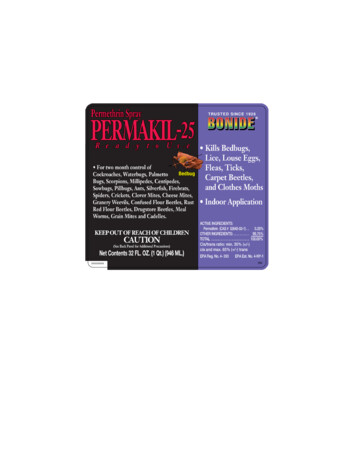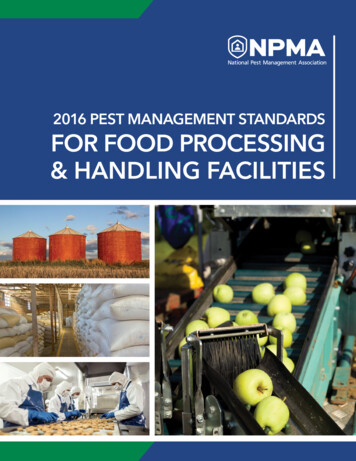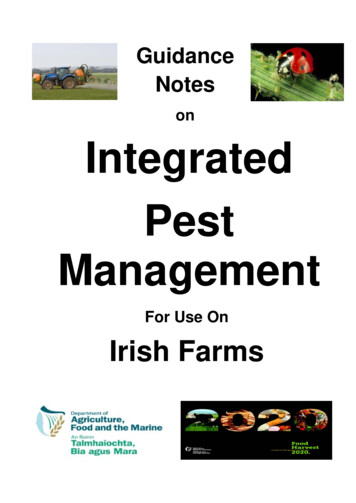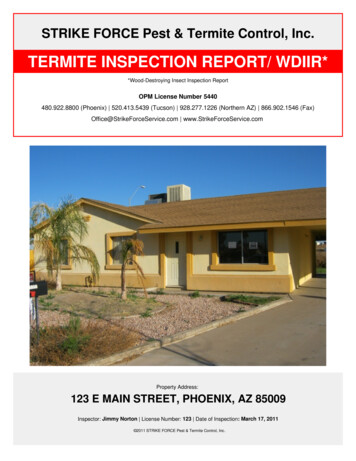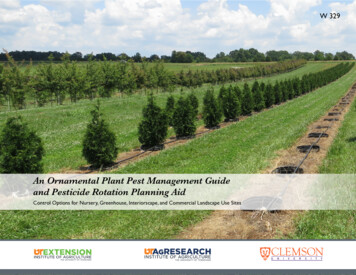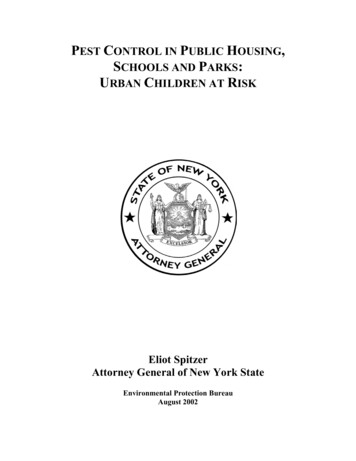
Transcription
PEST CONTROL IN PUBLIC HOUSING,SCHOOLS AND PARKS:URBAN CHILDREN AT RISKEliot SpitzerAttorney General of New York StateEnvironmental Protection BureauAugust 2002
PEST CONTROL IN PUBLIC HOUSING,SCHOOLS AND PARKS:URBAN CHILDREN AT RISKBYMichael H. Surgan, Ph.D., Chief ScientistThomas Congdon, Policy AnalystChristine Primi, Science AideStephanie Lamster, Science AideJennifer Louis-Jacques, Science AideEnvironmental Protection BureauPeter Lehner, Bureau ChiefAugust, 2002
ACKNOWLEDGMENTSThis report would not have been possible without the assistance of many colleagues andinterns in the Attorney General’s Office. Specifically, the authors wish to acknowledgeInvestigators Mike Finamore, Herb Antomez and Bill Cullen, and Interns Michelle Stern, LaurendeChiara, Jordan Goldsmith, Rachel Hymes, Jeff Gall, Ryan McPherson, Mike Marando, JoshStack, Kate Ramsey, Via Winkeller and Alicia Strazza for their work on the door-to-door residentsurveys. Investigators Sandra Migaj, Paul Scherf, John Katzenstein, Confidential Assistant MichaelHearn, Environmental Scientist Raymond Vaughn, and Intern Calista McIntyre assisted with theretail store shelf surveys. Assistant Attorneys General Roberto Lebron and Timothy Hoffman, withguidance from Assistant Attorney General Lemuel Srolovic, prosecuted the cases of illegal pesticidesales by retail stores. Former Assistant Attorney General Laura Blackman helped to plan theinvestigation and draft questionnaires.Gary Alpert, Ph.D. (Harvard University), David Hahn-Baker (Buffalo Pest ManagementBoard), and Philip J. Landrigan, MD (Mount Sinai School of Medicine) provided valuableassistance in developing the surveys.The authors wish to thank the following institutions for cooperating with the survey: AlbanyHousing Authority, Albany Department of General Services, Giffen Elementary School, Arbor HillElementary School, Buffalo Municipal Housing Authority, Buffalo Parks Department, LincolnAcademy, North Park Middle Academy, Houghton Academy, New York City Housing Authority,New York City Department of Parks and Recreation, New York City Office of School Food andNutritional Services, Syracuse Housing Authority, Syracuse Parks Department, Martin Luther King,Jr. School, Blodgett Elementary School, Yonkers Municipal Housing Authority, Yonkers ParksDepartment, and Yonkers Public Schools.Lastly, the authors also wish to thank the residents who facilitated the door-to-door surveysand provided critical information about their developments: Ms. Tara Lynch, Executive Director ofthe Buffalo Municipal Housing Residents Council Corporation; Ms. Sarah Martin, President of theGeneral Grant Houses Resident Association; Mr. Duane Jenkins, Vice President of the ThroggsNeck Houses Resident Association; Ms. Gladys Smith, Chair of the Citywide Council of SyracuseLow Income Housing Residents; and Ms. Beverly Blagmon, President of the Yonkers TenantsCouncil.
FOREWORDIn 1999, commercial pesticide applicators applied 4.1 million pounds of dry pesticides and820,000 gallons of liquid pesticide to homes, apartments, schools, parks, day care centers, seniorcenters, hospitals, offices and office buildings across New York State. Homeowners, landlords andapartment dwellers purchased many additional thousands of pounds of pesticides for privateapplication.The pesticides used in New York include carcinogens, endocrine disruptors, chemicalscapable of causing birth defects, and chemicals that can cause brain damage.Children are especially sensitive to pesticides. Pound for pound, children have greaterexposure to pesticides than adults because they live and play close to the floor, breathe close to theground and constantly put their fingers into their mouths. Children’s developing organ systems arehighly vulnerable to pesticides. Exposures of children to pesticides in the womb and during the firstyears after birth are linked to an increased risk of cancer and to increased risks of injury to the brainand nervous system.Most of the pesticides that are used and sold within the State of New York are legal. Thesechemicals are registered with the U.S. Environmental Protection Agency (EPA) and the New YorkDepartment of Environmental Conservation (DEC). Their use is permitted under federal and statelaw despite their well-recognized toxicity. This dangerous situation has arisen because until veryrecently pesticide standards were set through a balancing process that weighed health benefitsagainst claims – often poorly supported claims – for the economic benefits of pesticide use. Thetwo lessons to be learned here are (1) that governmental sanction is not a guarantee of pesticidesafety, and (2) that agencies and consumers need to learn about the hazards of the pesticides thatthey use and take intelligent steps to reduce pesticide use, whenever possible.Illegal pesticides are also applied in New York. These are pesticides that have been importedillegally into the United States or that are used in an illegal manner. These unauthorized chemicalsare often highly toxic, and they pose grave dangers to human health, especially to the health ofchildren. The report signals a need for increased enforcement of state pesticide laws.Now with publication of Pest Control in Public Housing, Schools and Parks: Urbani
Children at Risk, the Office of the Attorney General has developed a balanced, sensible andevidence-based approach for addressing the problem of pesticide toxicity in New York State. Thereport is based on a detailed survey of pest control practices in the public housing, schools and parksof five major cities across the State coupled with door-to-door surveys of the pesticide use practicesof residents in these same five cities, and surveys of stores to determine what pesticides are offeredfor sale.This path-breaking report is one of the very first to focus on pest control policies andpractices that affect the cumulative pesticide exposure of urban children in the places where theyspend most of their time. This detailed investigation confirms that toxic pesticides are usedextensively in apartments, schools, and parks across New York State by government agencies andcommercial applicators, as well as by residents. Two very important findings are (1) that there areno statewide policy guidelines for pesticide use and (2) that practices for pesticide use differ fromcity to city and from agency to agency. There is also no statewide plan in place, except at theDepartment of Education, to reduce use of toxic pesticides. This report should be a wake-up callto state and local agencies to be more active in reducing the exposure of children to pesticides.Most disturbing, the Attorney General’s survey discovered that some very dangerouspesticides are used by governmental agencies in places where people live, work and play. Forexample, the New York City schools, the Syracuse schools and the Albany Housing Authority usehydramethylnon, a pesticide classified by U.S. EPA as a “possible carcinogen.” The SyracuseHousing Authority uses baygon, a “probable carcinogen.” Residents make wide use oforganophosphate and carbamate pesticides, classes of pesticide chemicals that are deliberatelydesigned to damage the nervous system. All of these chemicals are applied in areas frequented byinfants and children.On the basis of these findings, the Office of the Attorney General has developed a clearlyconceived and feasible series of recommendations to reduce pesticide use in New York State.The Attorney General states that the essential heart of any pesticide use reduction programis a “clear and unambiguous pest control strategy.” Such strategies need to identify who is in chargeof a program, they need to incorporate approaches that avoid or minimize reliance on chemicalpesticides, and they must have clearly defined procedures for notification of the public whenpesticides are to be used. As a positive example, the Attorney General praises the School IntegratedPest Management and Neighbor Notification Guidelines of the New York State Department ofEducation, noting that by “following these guidelines, schools can go a long way toward reducingpesticide use.”ii
Pest Control in Public Housing, Schools and Parks: Urban Children at Risk, from the Officeof the Attorney General is an important document that needs to be read widely. It is “must reading”for all officials in agencies across the State that use pesticides and for all landlords.The wise and well-considered recommendations of this report will produce many benefits.They will reduce toxic pesticide exposures. They will reduce the frequency of disease, especiallyin our children, that is caused by chemical pesticides. And they will save New Yorkers money. Therecommendations will save money because diseases in children that are caused by pesticides andother toxic chemicals cost the State of New York billions of dollars in health care costs each year,and because chemical pesticides are themselves very expensive. By reducing the use of chemicalpesticides, the Attorney General’s recommendations will save New Yorkers money in the short runby reducing purchases of these expensive chemicals, and they will save still more money in the longrun by preventing unnecessary disease and disability.I recommend this report highly to all who care about the environment of New York, to allwho care for the health of New York’s children, and to all who believe in the importance of goodgovernment.Philip J. Landrigan, M.D., M.Sc.Professor and Chair,Department of Community and Preventive MedicineDirector, Center for Children’s Health and the EnvironmentMount Sinai School of Medicineiii
TABLE OF CONTENTSFOREWORD . . . . . . . . . . . . . . . . . . . . . . . . . . . . . . . . . . . . . . . . . . . . . . . . . . . . . . . . . . . . . . . . iCHAPTER 1 -- EXECUTIVE SUMMARY . . . . . . . . . . . . . . . . . . . . . . . . . . . . . . . . . . . . . . . 1CHAPTER 2 -- INTRODUCTION . . . . . . . . . . . . . . . . . . . . . . . . . . . . . . . . . . . . . . . . . . . . . . 8CHAPTER 3 -- METHODS . . . . . . . . . . . . . . . . . . . . . . . . . . . . . . . . . . . . . . . . . . . . . . . . . . . 11CHAPTER 4 -- PESTICIDE USE BY INSTITUTIONS AND INDIVIDUALS . . . . . . . . . 15A.B.Pesticide Use By Institutions . . . . . . . . . . . . . . . . . . . . . . . . . . . . . . . . . . . . . . . . 151.Active Ingredients . . . . . . . . . . . . . . . . . . . . . . . . . . . . . . . . . . . . . . . . . . 152.Institutional Use of Restricted Use Pesticides . . . . . . . . . . . . . . . . . . . . . 18Pesticide Use by Residents . . . . . . . . . . . . . . . . . . . . . . . . . . . . . . . . . . . . . . . . . 191.Frequency of Pesticide Applications . . . . . . . . . . . . . . . . . . . . . . . . . . . . 212.Illegal Pesticides Used by Residents . . . . . . . . . . . . . . . . . . . . . . . . . . . . 233.Availability of Pesticides in Local Stores . . . . . . . . . . . . . . . . . . . . . . . . 244.Non-Pesticidal Pest Control . . . . . . . . . . . . . . . . . . . . . . . . . . . . . . . . . . . 26CHAPTER 5 -- HEALTH IMPACTS OF FREQUENTLY USED PESTICIDES . . . . . . . 27A.Exposure to Pesticides - Unanticipated Mechanisms, Unintended Effects . . . . . 27B.Health Effects of Commonly Selected Pesticides . . . . . . . . . . . . . . . . . . . . . . . . 291.Toxicity of Specific Classes of Active Ingredients Used byResidents and Institutions . . . . . . . . . . . . . . . . . . . . . . . . . . . . . . 302.Carcinogenicity of Pesticides Used by Residents and Institutions . . . . . 333.The Asthma Paradox . . . . . . . . . . . . . . . . . . . . . . . . . . . . . . . . . . . . . . . . 364.Other Health-Related Impacts of Pesticides Used byResidents and Institutions . . . . . . . . . . . . . . . . . . . . . . . . . . . . . . 375.Toxicity of Unidentified Inert Ingredients . . . . . . . . . . . . . . . . . . . . . . . 38CHAPTER 6 -- THE REGULATION AND MANAGEMENT OF PESTICIDES . . . . . . . 40A.Pesticide Registration . . . . . . . . . . . . . . . . . . . . . . . . . . . . . . . . . . . . . . . . . . . . . 40B.New York State Neighbor Notification Law . . . . . . . . . . . . . . . . . . . . . . . . . . . . 43
C.State Education Department Pest Management Guidelines . . . . . . . . . . . . . . . . 44D.Municipal Pesticide Sunset Laws . . . . . . . . . . . . . . . . . . . . . . . . . . . . . . . . . . . . 44E.Institutional Pest Management Policies . . . . . . . . . . . . . . . . . . . . . . . . . . . . . . . . 45F.Record-keeping and Notification Requirements and Policies . . . . . . . . . . . . . . . 47G.A Special Concern: Use of Illegal Pesticides . . . . . . . . . . . . . . . . . . . . . . . . . . . 50CHAPTER 7 -- RECOMMENDATIONS . . . . . . . . . . . . . . . . . . . . . . . . . . . . . . . . . . . . . . . . 53A.Institutional Pest Control Programs - Recommendations . . . . . . . . . . . . . . . . . . 531.Written Policies . . . . . . . . . . . . . . . . . . . . . . . . . . . . . . . . . . . . . . . . . . . . 532.Integrated Pest Management . . . . . . . . . . . . . . . . . . . . . . . . . . . . . . . . . . 553.Pest Control Options . . . . . . . . . . . . . . . . . . . . . . . . . . . . . . . . . . . . . . . . 584.Certified Pesticide Applicators . . . . . . . . . . . . . . . . . . . . . . . . . . . . . . . . 635.Public Notification . . . . . . . . . . . . . . . . . . . . . . . . . . . . . . . . . . . . . . . . . . 636.Maintenance of Records . . . . . . . . . . . . . . . . . . . . . . . . . . . . . . . . . . . . . 64B.Resident Responsibilities - Implementing IPM in the Home . . . . . . . . . . . . . . . 65C.Action Points to Protect Our Children . . . . . . . . . . . . . . . . . . . . . . . . . . . . . . . . . 661.Housing Authorities . . . . . . . . . . . . . . . . . . . . . . . . . . . . . . . . . . . . . . . . . 662.Schools . . . . . . . . . . . . . . . . . . . . . . . . . . . . . . . . . . . . . . . . . . . . . . . . . . . 673.Parks . . . . . . . . . . . . . . . . . . . . . . . . . . . . . . . . . . . . . . . . . . . . . . . . . . . . . 674.Residents . . . . . . . . . . . . . . . . . . . . . . . . . . . . . . . . . . . . . . . . . . . . . . . . . 685.Retail Stores . . . . . . . . . . . . . . . . . . . . . . . . . . . . . . . . . . . . . . . . . . . . . . . 686.New York State Legislature . . . . . . . . . . . . . . . . . . . . . . . . . . . . . . . . . . . 68ENDNOTES . . . . . . . . . . . . . . . . . . . . . . . . . . . . . . . . . . . . . . . . . . . . . . . . . . . . . . . . . . . . . . . . 69APPENDIX I - FINDINGS IN THE FIVE CITIES . . . . . . . . . . . . . . . . . . . . . . . . . . . . . . . A.1APPENDIX II - NAME AND QUANTITY OF PESTICIDES APPLIED . . . . . . . . . . . . A.18APPENDIX III - ALBANY COUNTY’S PESTICIDE PHASE-OUT ORDINANCE . . . A.22APPENDIX IV - BROCHURE: GOT RATS? GOT MICE? . . . . . . . . . . . . . . . . . . . . . . . A.27APPENDIX V - BROCHURE: BUG PROBLEMS? . . . . . . . . . . . . . . . . . . . . . . . . . . . . . A.29
CHAPTER 1 – EXECUTIVE SUMMARYInfants and children are not simply little adults when it comes to poisons such as pesticides.Their ignorance of the dangers, and their tendency to crawl on floors, explore new objects, and puthands and other things in their mouths make them especially likely to be exposed to pesticides.Their developing bodies and changing metabolism increases their vulnerability. In short, childrenare at special risk.Pesticides – poisons designed to kill or otherwise eliminate pests – can cause a wide rangeof health impacts. While some effects may be immediately apparent, such as vomiting or tremors,other impacts are more subtle and pernicious. Commonly used pesticides can cause long-termneurological damage, developmental or reproductive disorders, and cancer.While the dietary exposure of children to pesticides has received some attention – mostsignificantly, the 1996 Food Quality Protection Act directs the federal government to re-examinefood pesticide residues with specific attention to the extra sensitivity of infants and children –environmental exposure, especially of urban children, has largely escaped notice. State records,however, show that commercial applicators apply large amounts of pesticides in urban areas. (NewYork City, for example, accounted for 27% of the total solid pesticides and 36% of the total liquidpesticides commercially applied or sold to farmers statewide.) This report seeks to fill that void byexamining the non-dietary exposure to pesticides of children in five New York cities – Albany,Buffalo, New York City, Syracuse and Yonkers – in their homes, schools and nearby parks, areaswhere urban children spend 90% or more of their time.Experience elsewhere conclusively demonstrates that people need not live with pests ifthey forgo pesticides. Indeed, many municipalities and housing developments have dramaticallyreduced pests with no pesticide use at all, largely through improved maintenance and sanitation.Other programs to reduce pesticide use yielded cost savings of 50% to 75%, and still achievedsuccessful pest control. Much of the exposure of urban children to pesticides may beunnecessary.The Attorney General’s Environmental Protection Bureau obtained information about theidentity and quantity of pesticides – insecticides, rodenticides, and herbicides – used and pesticideuse policies from the administrators of public housing developments and nearby schools and parksin each of the cities. We also surveyed residents to determine their personal pest control practices.Finally, we visited local retail stores to determine the availability of particular pesticide products tolocal residents.1
Our findings are a cause for concern. Housing authorities, school and parkadministrators, and the children’s parents frequently use toxic pesticides in areas where childrenmay be exposed. These pesticides include some that may cause cancer, interfere with the normaldevelopment of a child’s nervous system, increase the incidence of asthmatic attacks, or irritatethe skin, eyes, respiratory system and digestive system.In particular, the survey identified pesticide application practices that do not adequatelyreflect these known health risks: Only two of the 15 institutions we surveyed – the Syracuse Housing Authority andthe New York City Housing Authority – have adopted written pest managementpolicies, even though clear policies are essential to an effective pest control program. Eight out of ten housing developments surveyed applied pesticides inside apartmentsand in common areas on a regular prophylactic basis, rather than limiting applicationto specific pest problems. This often leads to use of more pesticides than necessary.Statewide, 69% of responding residents applied pesticides in their own homes, and33% did so at least once a week. Many respondents reported using illegal pesticides (products that are not registeredby the U.S. Environmental Protection Agency or the New York State Department ofEnvironmental Conservation) and 12 of the 73 stores surveyed were found sellingillegal pesticides. Of 14 responding schools, 10 reported using pesticides, and schools in New YorkCity and Yonkers reported using restricted use pesticides (which must be applied by,or under the supervision of, a certified applicator due to their high toxicity to peopleor other non-target species or due to their potential to persist and accumulate in theenvironment). The State Education Department recommends that schools not usethese more toxic pesticides. All five housing authorities reported using restricted use pesticides. Three parks, one in New York City and two in Yonkers, reported using herbicidesfor aesthetic, as opposed to health-related, purposes.2
None of the surveyed schools that applied pesticides notified students or parentsbefore pesticide applications during the 2000-01 academic year. (Effective July 1,2001, State Education Law required such notification.)Not surprisingly, pest problems and pesticide use were related to housing density. Mosts
Housing Authority, Albany Department of General Services, Giffe n Elementary School, Arbor Hill Elementary School, Buffalo Municipal Housing Authority, Buffalo Parks Department, Lincoln Academy, North Park Middle Aca
